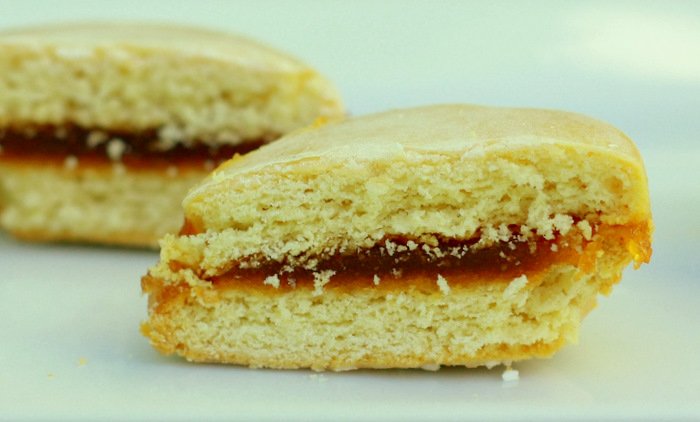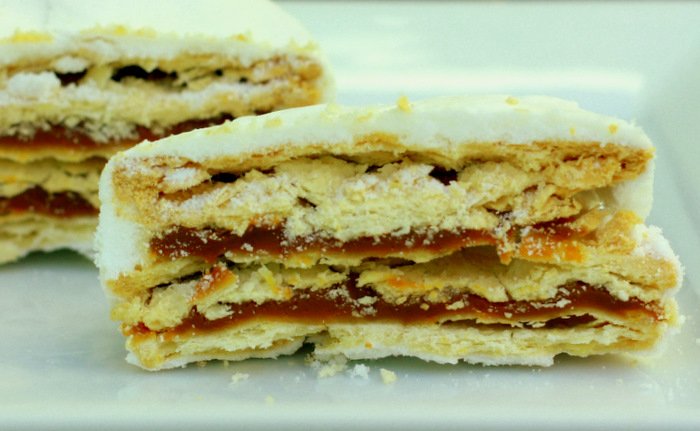Good morning friends! Let’s finish the week on a sweet note, shall we?
Last year, during our stay in Córdoba, I started preparing a few posts about Argentina’s sweet food culture. I could not finish writing these posts at the time, but I did take the pictures with the aim of showing you what we, Argentinians, think about when we think about sweets, what we love, what we miss when we are abroad. So here is the first of these posts, three in total, showcasing a small selection of my favourite treats. I need to give you one warning, though: there are many more sweets that I could not find in Córdoba (because they are typical of other provinces) or didn’t have the time to photograph. I also owe you a post on the candies and cookies from my childhood, which I meant to prepare, but my children kept eating the items to be photographed 😉
So, let’s begin! Today’s post is about the most popular of Argentina’s sweet treats: alfajores. But what are alfajores? And why are they called this way?
Alfajores are basically two cookies sandwiched together by some kind of sweet filling, be it fruit jam, dulce de leche, mousse or even ice cream. Their name comes from the arabic word “alajú”, and it is, in fact, an arabic confection that entered Spain during the Moorish era (during the period of Al-Andalus) and was then adopted -and modified- by the Spanish colonies. The shape and the recipes for the cookie itself and its fillings vary greatly from one country to the other, and even from one region to the other. According to wikipedia, the original confection (which can still be found in Spain) contained flour honey, spices and nuts and had a cilinder form (like a crêpe), while in Latinamerica alfajores are round and are normally filled with jams and mousses.Also, while in Spain they constitute a treat to be enjoyed mainly on special occasions (such as Christmas), except in the Medina Sidonia (where one can buy them all year long), in countries such as Argentina they are an everyday snack and can be bought in any kiosk.
Alfajores are different from a regular sandwich cookie, such as an oreo. The texture of the cookie itself is different: alfajores are moist and soft, and lack the crispiness of a traditional sandwich cookie. The filling is different as well, and more abundant. Whoopie pies, on the other side, look like an alfajor, and that is probably what we would call them back home in Argentina.
Argentina has different kinds of traditional alfajores, which differ from province to province. There are, of course, those that are available in kiosks nation-wide, produced by big candy companies, such as Arcor, Bagley or Terrabusi (owned by Kraft foods), but what is really interesting, and what I recommend you to do if you travel to Argentina one day, is to taste the regional versions, and compare them. In the following pictures I will show you some of these alfajores for you to get a glimpse at the variety you can find, and once I have tested and tweaked the recipes I brought from home, I will share them with you here as well.
The first type of alfajores I am showing you is perhaps the most famous one: Alfajor “Marplatense”, the alfajor from Mar del Plata, a seaside city in Buenos Aires province, which is also a traditional vacation spot.
Mar del Plata has many alfajor factories and, one of them, Havanna, has opened cafés and stores in several other countries, such as Israel, Spain, Mexico and the US. Havanna alfajores can also normally be found in shops that sell Latin-american products, as well as in Argentinian restaurants.
There are several types of alfajores from Mar del Plata: vanilla cookie with dulce de leche filling, covered in chocolate, vanilla cookie with dulce de leche filling covered in sugar glaze, vanilla and coffee cookie with dulce de leche filling and dark chocolate glaze, and vanilla and walnut cookie, with dulce de leche filling and covered in white chocolate glaze. They are all delicious, and their dulce de leche filling has the characteristic subtly smoky flavour that just burst in your mouth with the first bite and leaves you wanting more.
Alfajores from Córdoba are quite different, in two main aspects: the cookie is quite simple and light, the traditional filling is fruit jam instead of dulce de leche (normally, apple, pear or quince jam) and they are covered with a very simple sugar glaze made with only icing sugar and water that does not cover the cookie completely. Due to the popular love for dulce de leche, however, alfajores cordobeses with dulce de leche also exist, but they are not the traditional ones.
The cordobese confection that traditionally carries dulce de leche are colaciones, which are characterized by the crispy, curved nature of the cookie (that contains many egg yolks and a little bit of alcohol in the dough).
Alfajores from Santa Fé are also very popular. They are made of three layers of crispy, rather dry cookie (characterized because the dough has to be rolled and turned on itself 20 times, such as in the procedure for making puff pastry) , filled with dulce de leche (lots of dulce de leche, since the cookie itself is not overly sweet!) and covered with a sugar glaze made with icing sugar, water, lemon and egg whites.
Another very famous alfajor, which I couldn’t find in Córdoba to photograph, is the Alfajor Norteño (from Argentina’s North-West region), which is filled either with layers of dulce de leche and turrón, or only with turrón paste made with honey, egg-whites, sugar and walnuts.
I hope you liked this small introduction to our sweets and, worry not!, recipes will come soon!
And in case you are wondering who ate all those sweets that were photographed, it was a little blonde elf that helps me style food whenever he can…
Have a wonderful weekend!











Mmm estoy babeando. Ese cafe en el Triangle de Barcelona, me trae tantos recuerdos. Siempre pasabamos ahi por alfajores. Mark los sigue extrañando. Suerte que el otro dia, una colega argentina tuvo visita que llego con el respectivo cargo. Las colaciones de ven deliciosas, algun dia probare una. Y me encanta la cara de catador oficial de Luka, en plena interrogación.
Te tengo buenas noticias: venden alfajores argentinos en Holanda! http://www.ladespensa.nl/webshop/dulces–salados/alfajores/
Ya no hace falta que los vayan a buscar a Barcelona 🙂
Luka es re Darwin, él mira todo antes de dar el mordisco jajaja
ahhhh… se me pianta un lagrimon… gracias, gracias, gracias Malche…
Ahhhhhhhhhhhhh
Me había perdido este post!
Recomiendo porbar si andan por aca los terrabussi de chocolate (muy muy similares a las havanna actuales9
De los santafecinos los Gayali son los mas tradidionales (con uno cada 6 meses me alcanza el empalague para el año entero)
De todos modos, en mis años en santa fe, los unicos alfajores que encargaba eran los de fruta bañados en glase cordobeces ;P
Para cuando la visita a la fabria original Havanna?? 😉
Besote!
Siii, los gayali son un clásico…y a mi tambien me empalagan! Son como una torta rogel sin el merengue italiano arriba.
La visita a la fabrica quedará para dentro de unos años, cuando volvamos, si Dios quiere 😉
Besotes!